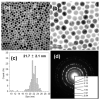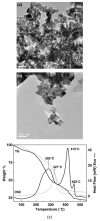Magnetic Iron Oxide Nanoparticle (IONP) Synthesis to Applications: Present and Future
- PMID: 33080937
- PMCID: PMC7603130
- DOI: 10.3390/ma13204644
Magnetic Iron Oxide Nanoparticle (IONP) Synthesis to Applications: Present and Future
Abstract
Iron oxides are chemical compounds which have different polymorphic forms, including γ-Fe2O3 (maghemite), Fe3O4 (magnetite), and FeO (wustite). Among them, the most studied are γ-Fe2O3 and Fe3O4, as they possess extraordinary properties at the nanoscale (such as super paramagnetism, high specific surface area, biocompatible etc.), because at this size scale, the quantum effects affect matter behavior and optical, electrical and magnetic properties. Therefore, in the nanoscale, these materials become ideal for surface functionalization and modification in various applications such as separation techniques, magnetic sorting (cells and other biomolecules etc.), drug delivery, cancer hyperthermia, sensing etc., and also for increased surface area-to-volume ratio, which allows for excellent dispersibility in the solution form. The current methods used are partially and passively mixed reactants, and, thus, every reaction has a different proportion of all factors which causes further difficulties in reproducibility. Direct active and complete mixing and automated approaches could be solutions to this size- and shape-controlled synthesis, playing a key role in its exploitation for scientific or technological purposes. An ideal synthesis method should be able to allow reliable adjustment of parameters and control over the following: fluctuation in temperature; pH, stirring rate; particle distribution; size control; concentration; and control over nanoparticle shape and composition i.e., crystallinity, purity, and rapid screening. Iron oxide nanoparticle (IONP)-based available clinical applications are RNA/DNA extraction and detection of infectious bacteria and viruses. Such technologies are important at POC (point of care) diagnosis. IONPs can play a key role in these perspectives. Although there are various methods for synthesis of IONPs, one of the most crucial goals is to control size and properties with high reproducibility to accomplish successful applications. Using multiple characterization techniques to identify and confirm the oxide phase of iron can provide better characterization capability. It is very important to understand the in-depth IONP formation mechanism, enabling better control over parameters and overall reaction and, by extension, properties of IONPs. This work provides an in-depth overview of different properties, synthesis methods, and mechanisms of iron oxide nanoparticles (IONPs) formation, and the diverse range of their applications. Different characterization factors and strategies to confirm phase purity in the IONP synthesis field are reviewed. First, properties of IONPs and various synthesis routes with their merits and demerits are described. We also describe different synthesis strategies and formation mechanisms for IONPs such as for: wustite (FeO), hematite (α-Fe2O3), maghemite (ɤ-Fe2O3) and magnetite (Fe3O4). We also describe characterization of these nanoparticles and various applications in detail. In conclusion, we present a detailed overview on the properties, size-controlled synthesis, formation mechanisms and applications of IONPs.
Keywords: biomedical; formation mechanisms; iron oxide nanoparticles (IONPs); reproducible.
Conflict of interest statement
The authors declare no conflict of interest.
Figures












Similar articles
-
Black is the new orange: inline synthesis of silica-coated iron oxide nanoparticles produced via gas-phase in a matrix burner.RSC Adv. 2025 May 8;15(19):15121-15130. doi: 10.1039/d5ra00808e. eCollection 2025 May 6. RSC Adv. 2025. PMID: 40343314 Free PMC article.
-
Synthesis, Functionalization, and Biomedical Applications of Iron Oxide Nanoparticles (IONPs).J Funct Biomater. 2024 Nov 12;15(11):340. doi: 10.3390/jfb15110340. J Funct Biomater. 2024. PMID: 39590545 Free PMC article. Review.
-
Alternating magnetic field-induced hyperthermia increases iron oxide nanoparticle cell association/uptake and flux in blood-brain barrier models.Pharm Res. 2015 May;32(5):1615-25. doi: 10.1007/s11095-014-1561-6. Epub 2014 Nov 7. Pharm Res. 2015. PMID: 25377069 Free PMC article.
-
Surface engineering of magnetic iron oxide nanoparticles by polymer grafting: synthesis progress and biomedical applications.Nanoscale. 2020 Jul 23;12(28):14957-14975. doi: 10.1039/d0nr03346d. Nanoscale. 2020. PMID: 32648868 Review.
-
Defects or no defects? Or how to design 20-25 nm spherical iron oxide nanoparticles to harness both magnetic hyperthermia and photothermia.Nanoscale. 2024 Nov 13;16(44):20542-20555. doi: 10.1039/d4nr01397b. Nanoscale. 2024. PMID: 39422589
Cited by
-
Influence of Physicochemical Properties of Iron Oxide Nanoparticles on Their Antibacterial Activity.ACS Omega. 2024 Jul 25;9(31):33303-33334. doi: 10.1021/acsomega.4c02822. eCollection 2024 Aug 6. ACS Omega. 2024. PMID: 39130596 Free PMC article. Review.
-
Transferrin-Conjugated Melittin-Loaded L-Arginine-Coated Iron Oxide Nanoparticles for Mitigating Beta-Amyloid Pathology of the 5XFAD Mouse Brain.Int J Mol Sci. 2023 Oct 6;24(19):14954. doi: 10.3390/ijms241914954. Int J Mol Sci. 2023. PMID: 37834402 Free PMC article.
-
A Comprehensive Updated Review on Magnetic Nanoparticles in Diagnostics.Nanomaterials (Basel). 2021 Dec 17;11(12):3432. doi: 10.3390/nano11123432. Nanomaterials (Basel). 2021. PMID: 34947781 Free PMC article. Review.
-
Non-Heating Alternating Magnetic Field Nanomechanical Stimulation of Biomolecule Structures via Magnetic Nanoparticles as the Basis for Future Low-Toxic Biomedical Applications.Nanomaterials (Basel). 2021 Aug 31;11(9):2255. doi: 10.3390/nano11092255. Nanomaterials (Basel). 2021. PMID: 34578570 Free PMC article. Review.
-
Synthesis, characterization and application of steel waste-based iron oxide nanoparticles for removal of heavy metals from industrial wastewaters.Heliyon. 2024 Mar 15;10(6):e28153. doi: 10.1016/j.heliyon.2024.e28153. eCollection 2024 Mar 30. Heliyon. 2024. PMID: 38524616 Free PMC article.
References
-
- Noqta O.A., Aziz A.A., Usman I.A., Bououdina M. Recent Advances in Iron Oxide Nanoparticles (IONPs): Synthesis and Surface Modification for Biomedical Applications. J. Supercond. Nov. Magn. 2019;32:779–795. doi: 10.1007/s10948-018-4939-6. - DOI
-
- Iriarte-Mesa C., López Y.C., Matos-Peralta Y., de la Vega-Hernández K., Antuch M. Gold, Silver and Iron Oxide Nanoparticles: Synthesis and Bionanoconjugation Strategies Aimed at Electrochemical Applications. Volume 378. Springer International Publishing; Berlin/Heidelberg, Germany: 2020. - PubMed
-
- Trindade T., Thomas P.J. Defining and Using Very Small Crystals. Volume 4. Elsevier Ltd.; Amsterdam, The Netherlands: 2013. - DOI
-
- Tringides M.C., Jałochowski M., Bauer E. Quantum size effects in metallic nanostructures. Phys. Today. 2007;60:50–54. doi: 10.1063/1.2731973. - DOI
Publication types
LinkOut - more resources
Full Text Sources
Other Literature Sources

